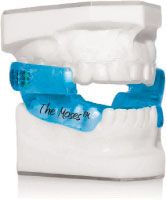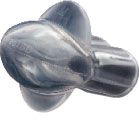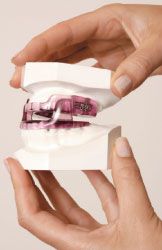While you were sleeping
Everyone has stories about the snorer in their family. Many a funny tale has been told about that uncle or father or even that spouse who had to sleep on the couch. But snoring and other sleep problems are no laughing matter.
Everyone has stories about the snorer in their family. Many a funny tale has been told about that uncle or father or even that spouse who had to sleep on the couch. But snoring and other sleep problems are no laughing matter.
In fact, obstructive sleep apnea (OSA)-a condition in which the tongue and the soft palate relax and close off the airway so air cannot flow into the lungs-has been linked to numerous health problems. According to the Dental Sleep Medicine of Illinois website, research has tied sleep apnea to heart attacks, morning headaches, high blood pressure and increased risk of stroke, not to mention how fatigue increases the risks of work accidents and devastating motor vehicle accidents.
But what does snoring and sleep apnea have to do with general dental practices? Actually it can and should have an awful lot to do with you and your practice. Recent studies have proven that oral appliance therapy is effective when treating patients with mild to moderate sleep apnea-that’s where big opportunities can arise for dentists.
“Sleep disorders are said to affect nearly 30% of the population, which means three of every 10 of my dental patients probably have some sort of problem with it,” said Dr. Steve Carstensen, FAGD, FICD, FACD. “When we talk about it with patients, it seems that nearly every patient snores, has been diagnosed with something more serious, or has a friend or family member with it. So, it touches nearly every dental patient.”
Not only can you attract new patients by offering dental sleep medicine services, but you also can offer new services-and in many cases a better night’s sleep-to existing patients.

You’ll need to know the difference between snoring and sleep apnea, and you’ll need to know a little about CPAP (Continuous Positive Airway Pressure) devices. But first and foremost you need to know just exactlywhat the dentist’s role is in treating sleep disorders, and know that this role is changing and may vary from state to state.
Sleep apnea vs. snoring
Many people mistake sleep apnea and snoring as one in the same. Snoring is the harsh sound heard when a snorer inhales during sleep. This occurs when the soft palate and the uvula vibrate against the back of the throat or base of the tongue. Apnea, meanwhile, closes off the airway and creates “pauses” in breathing that can occur anywhere from five times to 100 times per hour.
“There is a spectrum of sleep disorder breathing and on one end of the spectrum we have snoring and the other end of the spectrum we have sleep apnea,” said Dr. Wesley Fleming, M.D., who is double board certified in sleep medicine and adult neurology, but practices sleep medicine exclusively. “Snoring usually proceeds sleep apnea. Snoring is evidence of restriction of airflow, so when a person snores it is because there is restriction of airflow causing a vibration of tissue in the back of the throat as they breath. When a person has sleep apnea that restriction is greater causing a sometimes closure of the airway.”

Dr. Robert L. Horchover, whose Seattle practice is limited to obstructive sleep apnea and snoring, said OSA is a big health problem because it affects millions of Americans and because of the severe problems it can cause. He adds that while diagnosing the problem must be left to physicians, dentists can play a big role in terms of screening and offering alternative treatments to the more traditional CPAPs, something that is needed because patients all too often don’t use the cumbersome devices that have been prescribed to them.
“It’s an enormous problem,” said Dr. Horchover, who had a general practice in Alaska before beginning his exclusive dental
sleep medicine practice 15 years ago. “On the personal side it’s usually painless, evolves slowly, and causes daytime fatigue. Also, it can lead to loss of memory, attention deficits, depression, impotence, increases risks of heart attack and stroke, diabetes, impedes weight loss and decreases marital and family relationships. A higher percent of people falling asleep when driving causes injury, death, property damage, job loss and disability.” Those are some pretty scary consequences; so helping your patients avoid them is a great thing to do.
“OSA is as present in any general dental practice as it is in the general population,” Dr. Horchover said. “Screening for OSA is simple and ‘positive’ symptoms and responses can be referred to a medical sleep specialist for diagnosis and traditional treatment. Dentists also can provide successful treatment through special oral devices. Identifying airway problems in children enables interceptive treatment that can prevent more severe problems later. Dentists can save lives by screening patients for OSA.”
First steps
When the American Academy of Sleep Medicine (aasmnet.org) designated oral appliances as the top treatment avenue for mild and moderate sleep apnea and snoring about five years ago, it gave a boatload of legitimacy to the treatment. That, coupled with the high percentage of non-compliant CPAP patients, has created a windfall of opportunities for dentists. Practice parameters recommend that oral appliance therapy be given as an option (along with CPAP) for patients diagnosed with mild to moderate OSA. In addition, it is recommended for patients with severe OSA who are not able to tolerate CPAP as therapy.
Dr. Lou Shuman, President of Pride Institute, expects this to be a big year for growth in the field of dental sleep medicine. Increased awareness on sleep apnea’s risks along with some big players getting involved on the manufacturing end of oral appliances could lead to booming expansion for dental sleep medicine.
“We see sleep as becoming one of the very hot topics of 2011,” Dr. Shuman said. “With proper education and training both to doctor and team, dental sleep medicine will ultimately be integrated into practice on a daily basis.”
But a few critical points need to be pointed out. Dentists cannot diagnose sleep apnea, and oral appliances are not always the best prescription for patients-it’s clearly not the first choice for severe cases of apnea, where CPAP should generally be the first choice recommended.
AADSM President Dr. Sheri Katz, also a Diplomate, American Board of Dental Sleep Medicine, said all dentists have the skills required to take good impressions and to learn to master the bite registrations needed to get involved in offering oral appliances. But that’s just a small part of delivering the best dental sleep care to your patients.
“It’s critical to learn about the field of sleep,” said Dr. Katz, who started her two-year term as the Academy’s president last June.
Dr. Barry Glassman, who limits his practice in Allentown, Penn., to dental sleep medicine, chronic pain management and temporomandibular joint dysfunction, said it is very important to remember to be clear on the role of both the dentist and the medical physician when it comes to dental sleep me medicine.
“It is critical to understand that we as dentists do NOT make the diagnosis of OSA. It is true that we can use ambulatory studies to screen patients prior to referring them to sleep medicine, to guide our titration of oral appliances, and therefore for outcome measurement,” said Dr. Glassman, who is the resident instructor of Dental Sleep Medicine at Lehigh Valley Hospital and is on staff at the Sacred Heart Hospital Sleep Disorder Center.
“Most of the ambulatory studies on the market are excellent for that purpose. They vary in their cost, the cost of disposables, and ease of use for the patient as well as ease of reading the diagnostic information gleaned from the study. It is important to understand that the airway we need to evaluate is the airway of a sleeping patient, and that awake parameters have very little value or relevance.”
An interview with somnomed’s president, CEO Ralf Barschow
Ralf Barschow has more than 20 years experience in leading international dental materials and technology companies, performing high executive functions, managing sales and marketing budgets up to $250 million (U.S.) as well as forging a network of business contacts in the dental industry worldwide.
Prior to accepting his role as Chief Executive Officer of SomnoMed, he came from the Australian subsidiary of Siemens AG, one of the world’s leading operations. Prior to that he was heading the central European business as Managing Director of the U.S. company Align Technology Inc., the NASDAQ listed inventor and maker of Invisalign, which is also where Jack Guthrie his VP of North American Sales and Customer Service originally worked as well. Barschow came to Align from his previous position as Global Sales Director of Ivoclar Vivadent AG; and prior to that as Export Manager and various positions he held for more than 10 years in the German Degussa AG, one of the larger dental companies in the world.
Barschow, a German citizen, studied international marketing and economics in Germany and England, lived in Germany, Liechtenstein, Singapore, Hong Kong and moved to Australia in 2006. In March 2011 he moved to the U.S. and in addition to his role as global CEO of SomnoMed Limited, Barschow has been appointed President of SomnoMed North America. SomnoMed’s sleep appliance is featured on the cover of this magazine, and Barschow agreed to answer a few questions from Dental Products Report as part of this cover story on sleep medicine.

Q How does your product compare with others on the market?
A The SomnoDent is currently the state-of-the art and clinically proven medical oral appliance for sleep apnea. The most comfortable and effective design and treatment solution for more than 60,000 patients in 20 countries.
Q How are your oral appliances manufactured?
A All medical oral appliances fabricated in wholly owned or authorized SomnoMed facilities are manufactured and audited to the ISO standard ISO 13485 worldwide.
Q Is any unique material integrated into the product?
A The SomnoDent and SomnoBrux product line can be ordered with the unique SMH BFlex polymer lining material. SMH BFlex is worldwide, exclusively available and used in SomnoMed products only with outstanding technical features in terms of comfort, stability and durability.
Q What quality systems/standards has your company adopted?
A SomnoMed is the only publicly listed medical company in the field of Dental Sleep Medical. We are following strict international medical quality regulations and standards, such as ISO, FDA, TGA, CE.
Q Why is it so important that patients receive a FDA cleared oral appliance?
A The FDA clearance represents only the absolute minimum requirement for an oral appliance to be medically recognized and approved for the treatment of obstructive sleep apnea. More important is the clinical evidence based documentation and proven long-term clinical studies.
Q Is any clinical evidence available to support the compliance, effectiveness and acceptance of your product?
A Proven clinical evidence is an absolute must for the patients safety and the doctors trust in the chosen therapy. The SomnoDent with its 11 years of clinical evidence, more than 60,000 patients received treatment worldwide, 14 independent, international clinical studies fulfill and exceed all criteria
Q What new technology/innovations can we expect from SomnoMed?
A To be expected soon is the launch of the next generation of the world’s No. 1 oral sleep apnea appliance. The SomnoDent G2 will again raise the standard in comfort, compliance and treatment for the patient and the doctor. We are also introducing SomnoMed MATRx a revolutionary breakthrough in the prediction of efficacy of an oral appliance in a full sleep study setting (PSG). More innovations are to be announced soon as we are investing significantly in Research and Development.
Q Are dentists provided with any training/education on your oral appliance?
A It is the principle and a company mantra for SomnoMed that there should be no treatment in sleep disordered breathing without a professional diagnostic and only by a qualified and trained doctor. With the SomnoMed Academy we are supporting this philosophy worldwide by providing qualification seminars or collaborating with and supporting institutions providing first class education with a particular focus on bridging the gap between the dental and medical fraternity.
Dr. Carstensen said that while dentists are not the ones who are diagnosing sleep apnea, they are indeed able to play a vital role in the whole treatment process.
“Dentists are not allowed to diagnose sleep apnea because this is a serious medical condition that often includes comorbidities that we are not trained to recognize, much less treat,” he said. “On the other hand, one of the major treatment modalities cannot be performed by physicians. No state restricts dentists from treating sleep disordered breathing patients, but there is at least one state where dentists are not allowed to even use portable monitors to check to see if the appliance in use is effective.
“Dentists who treat snoring without a thorough diagnosis are risking patient health because both the dentist and patient may assume the disease is fully controlled when the snoring is stopped. This is not supported by evidence.”
Work with the medical docs
Dentists must have some type of relationship with the physicians in their area to get regular referrals for oral appliance therapy-because they’re the ones doing the diagnosing. But you’ll also want the experts involved to help ensure your patients receive the best possible care.
Dr. Katz said this back and forth between dentist and sleep specialist/physician should come naturally.
“It’s kind of a neat thing. One of the paradigms that I like to take is that we all know as dentists how to work with our periodontists, with our orthodontists, with our oral surgeons…and we flow very nicely with them,” she said. “We send people over and say take care of this and they send the patient back and say this patient needs a filling, I saw a cavity over here, or how about you temporize this while I do the surgery over here. We seem to flow very nicely. We really want to encourage that type of protocol with the physicians. It makes practicing delightful to work as part of a team.
What’s best for the patient is when all of the physicians are on board because you are dealing with the underlying cause of so much disease. And you’re eliminating one of the factors (in sleep apnea).”
Dr. Carstensen believes some physicians may be unaware of the research backing OAT and that these doctors may not realize there are cases in which CPAP may not be the best solution, certainly in cases where the patient is much more likely to comply with a comfortable, less obtrusive option such as an oral appliance.
"Physicians want the best care for their patients, but they are very busy and most are challenged to keep up with the learning in a huge field of knowledge,” he said. “As they believe there are answers for a clinical profile, they don’t always go looking for alternatives.